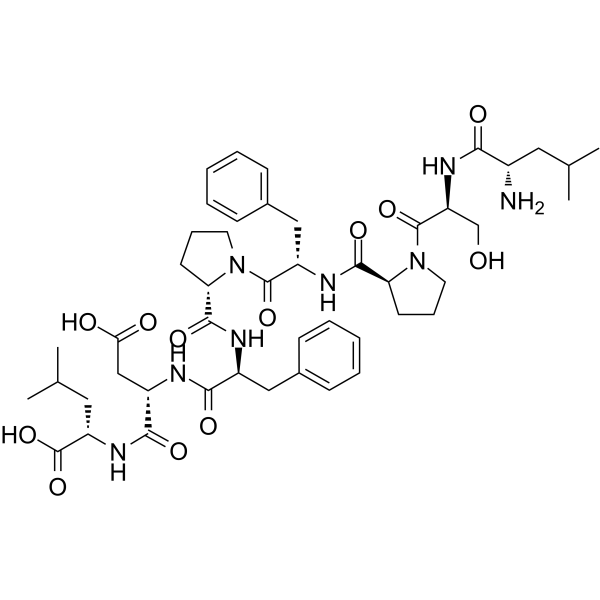Search Result
Results for "
peptide ligand
" in MedChemExpress (MCE) Product Catalog:
3
Biochemical Assay Reagents
| Cat. No. |
Product Name |
Target |
Research Areas |
Chemical Structure |
-
- HY-P1868A
-
|
DGEA peptide TFA
|
Integrin
|
Others
|
|
α2β1 Integrin Ligand Peptide TFA interacts with the α2β1 integrin receptor on the cell membrane and mediates extracellular signals into cells. It is a potential antagonist of collagen receptors .
|
-

-
- HY-P1186
-
|
Eledoisin-Related peptide; Eledoisin RP
|
Neurokinin Receptor
|
Neurological Disease
|
|
Eledoisin Related Peptide is a Substance P analog that excites neurons and triggers behavioral responses. Eledoisin Related Peptide is also a tachykinin receptor ligand.
|
-
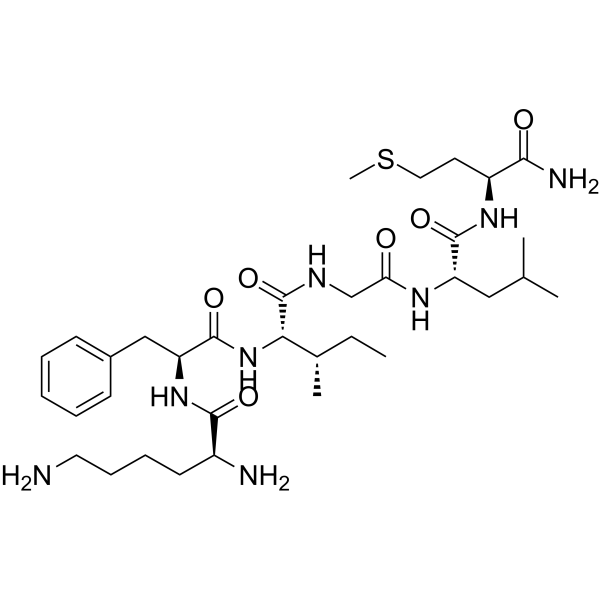
-
- HY-P5889
-
|
|
Thrombin
|
Cardiovascular Disease
|
|
Thrombin receptor peptide ligand is a thrombin receptor antagonist peptide that can be used as an antithrombotic agent .
|
-
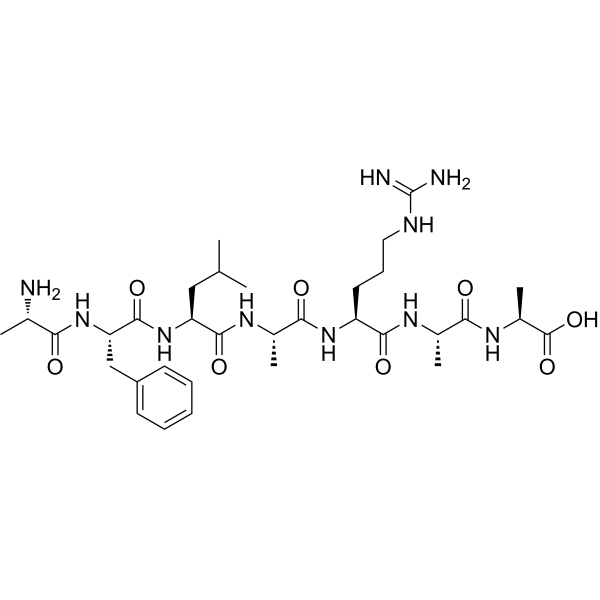
-
- HY-P4205
-
|
|
Aminopeptidase
|
Cancer
|
|
Aminopeptidase N Ligand (CD13) NGR peptide is a polypeptide targeting CD13 and can be used as a carrier to mediate intracellular transmission. Aminopeptidase N Ligand (CD13) NGR peptide is often used in cancer research .
|
-
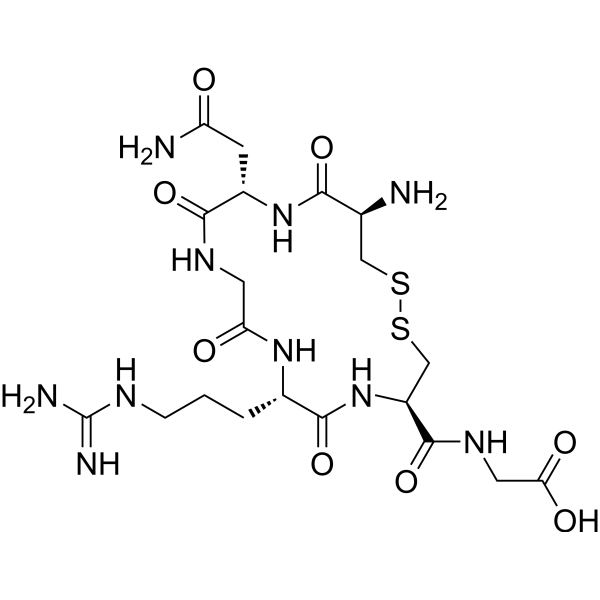
-
- HY-P1868
-
|
DGEA peptide
|
Integrin
|
Infection
|
|
α2β1 Integrin Ligand Peptide interacts with the α2β1 integrin receptor on the cell membrane and mediates extracellular signals into cells. It is a potential antagonist of collagen receptors .
|
-
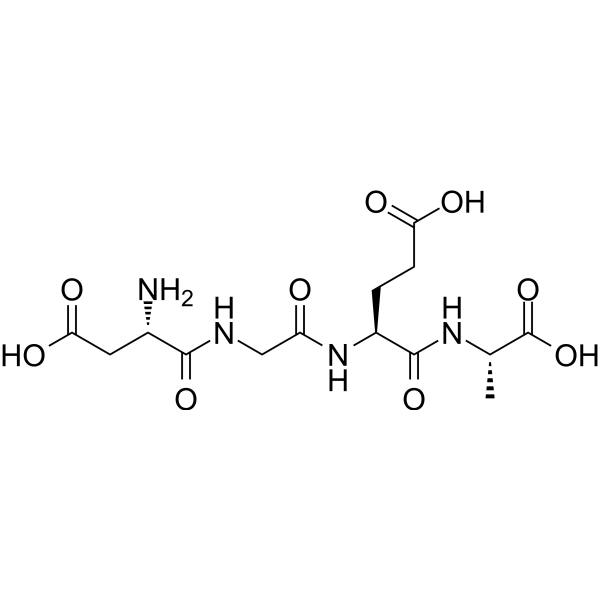
-
- HY-P4198
-
-
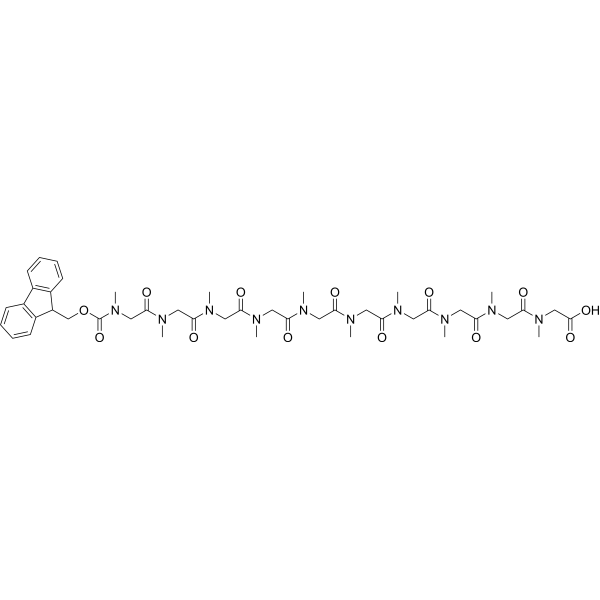
-
- HY-P4803
-
-
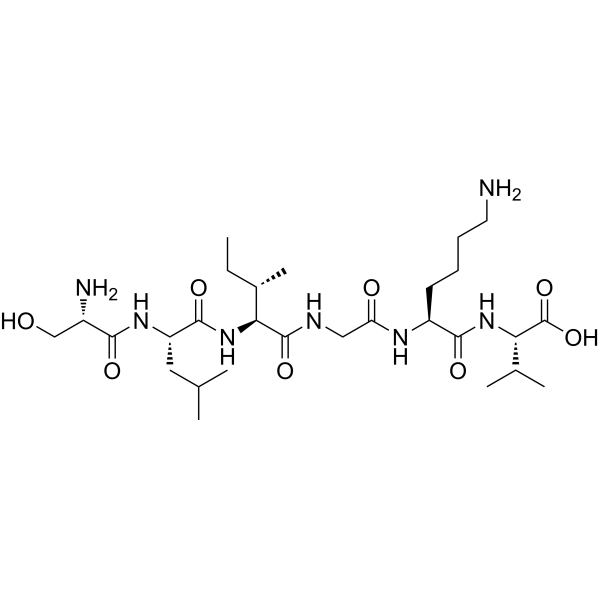
-
- HY-W343750
-
-
![[Tyr4]-Bombesin](//file.medchemexpress.com/product_pic/hy-w343750.gif)
-
- HY-P0272
-
|
|
HIV
|
Infection
|
|
Peptide T is an octapeptide from the V2 region of HIV-1 gp120. Peptide T is a ligand for the CD4 receptor and prevents binding of HIV to the CD4 receptor.
|
-
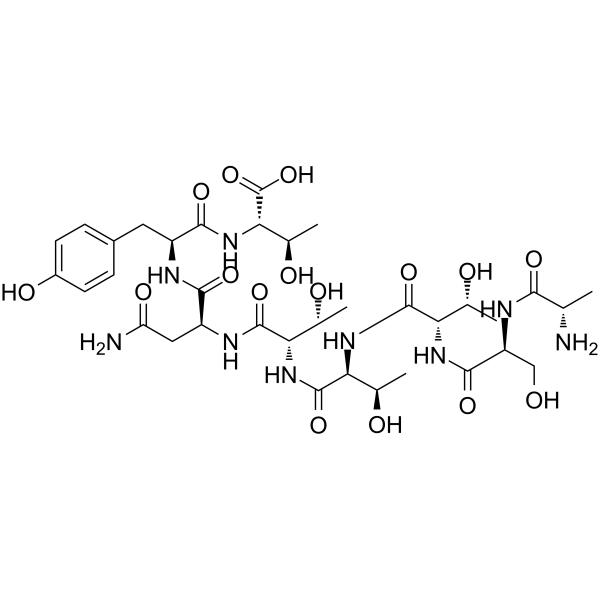
-
- HY-P0272A
-
|
|
HIV
|
Infection
|
|
Peptide T (TFA) is an octapeptide from the V2 region of HIV-1 gp120. Peptide T is a ligand for the CD4 receptor and prevents binding of HIV to the CD4 receptor.
|
-
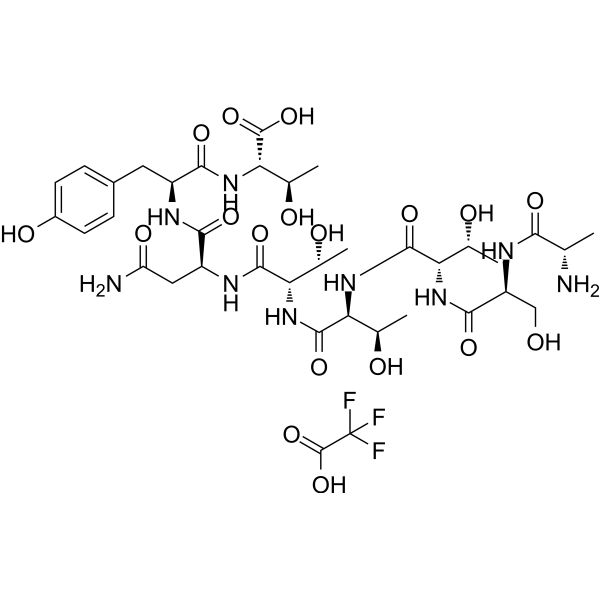
-
- HY-128941
-
|
|
Drug-Linker Conjugates for ADC
|
Cancer
|
|
CCK2R Ligand-Linker Conjugates 1 is a ligand-linker conjugate, which conjugates to the cytotoxic antimicrotubule agents Desacetyl Vinblastine Hydrazide (DAVBH) and Tubulysin B Hydrazide (TubBH) via a hydrophilic peptide linker .
|
-

-
- HY-P0224
-
|
fMLP; N-Formyl-MLF
|
TNF Receptor
|
Inflammation/Immunology
|
|
N-Formyl-Met-Leu-Phe (fMLP; N-Formyl-MLF) is a chemotactic peptide and a specific ligand of N-formyl peptide receptor (FPR). N-Formyl-Met-Leu-Ph is reported to inhibit TNF-alpha secretion.
|
-
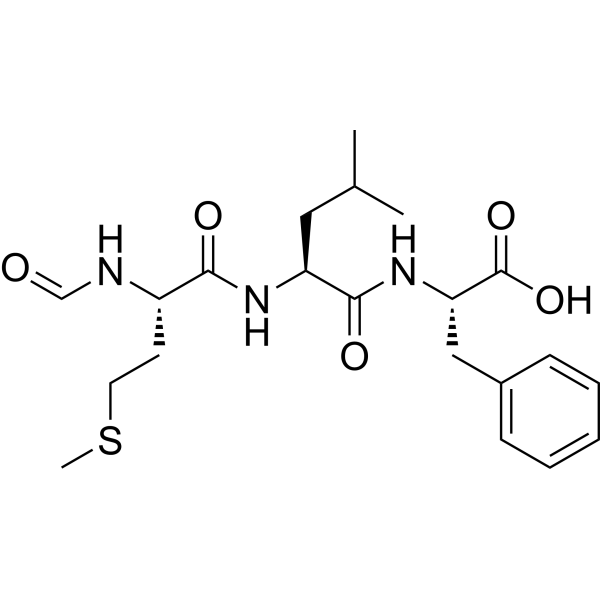
-
- HY-P5371
-
|
|
Thrombin
|
Others
|
|
TFLLRNPNDK-NH2 is a biological active peptide. (This peptide is a thrombin receptor activating peptide. This PAR-1 agonist peptide reversibly binds to PAR-1 mimicking the 'tethered ligand' that thrombin makes available through proteolytic cleavage of substrate. It is also known to cause increase in liquid and protein permeability much like thrombin.)
|
-
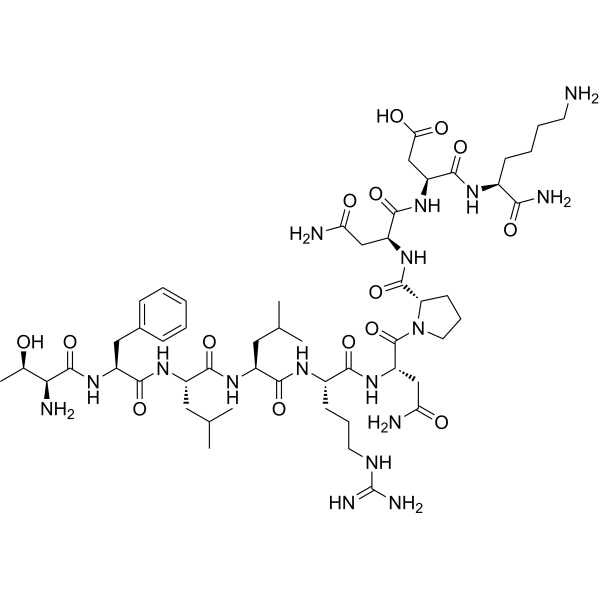
-
- HY-P3130
-
|
|
CRFR
|
Neurological Disease
Inflammation/Immunology
|
|
Stresscopin-related peptide (human) is a specific ligand for the type 2 CRH receptor. Stresscopin-related peptide (human) suppresses food intake, delayed gastric emptying and decreases heat-induced edema. Stresscopin-related peptide (human) maintains homeostasis after stress, and can be used in the research of stress-related diseases .
|
-

-
- HY-P4715
-
|
|
PTHR
|
Endocrinology
|
|
(Tyr36)-pTH-Related Protein (1-36) (human, mouse, rat) is a peptide and can be used as a parathyroid hormone (PTH) receptor ligand .
|
-

-
- HY-P1520
-
|
|
GnRH Receptor
|
Neurological Disease
|
|
Prolactin Releasing Peptide (1-31), human is a high affinity GPR10 ligand that cause the release of the prolactin. Prolactin Releasing Peptide (1-31) binds to GPR10 for human and rats with Ki values of 1.03 nM and 0.33 nM, respectively. Prolactin Releasing Peptide (1-31) can be used for the research of the hypothalamo-pituitary axis .
|
-

-
- HY-P2268
-
|
|
Amyloid-β
|
Inflammation/Immunology
Cancer
|
|
RAGE antagonist peptide is an advanced glycation end products (RAGE) antagonist. RAGE antagonist peptide prevents RAGE from binding with several of its most important ligands, including HMGB-1, S100P, and S100A4. RAGE antagonist peptide (RAP) possesses anti-tumor and anti-inflammatory activities .
|
-

-
- HY-P1520A
-
|
|
GnRH Receptor
|
Neurological Disease
|
|
Prolactin Releasing Peptide (1-31), human (acetate) is a high affinity GPR10 ligand that causes the release of the prolactin. Prolactin Releasing Peptide (1-31) binds to GPR10 for human and rats with Ki values of 1.03 nM and 0.33 nM, respectively. Prolactin Releasing Peptide (1-31) can be used for the research of the hypothalamo-pituitary axis .
|
-

-
- HY-P1740
-
|
|
Integrin
Apoptosis
|
Inflammation/Immunology
|
|
RGD peptide (GRGDNP) is an inhibitor of integrin-ligand interactions. RGD peptide (GRGDNP) competitively inhibits α5β1 binding with extracellular matrice (ECM). RGD peptide (GRGDNP) promotes apoptosis through activation of conformation changes that enhance pro-caspase-3 activation and autoprocessing. RGD peptide (GRGDNP) plays an important role in cell adhesion, migration, growth, and differentiation .
|
-
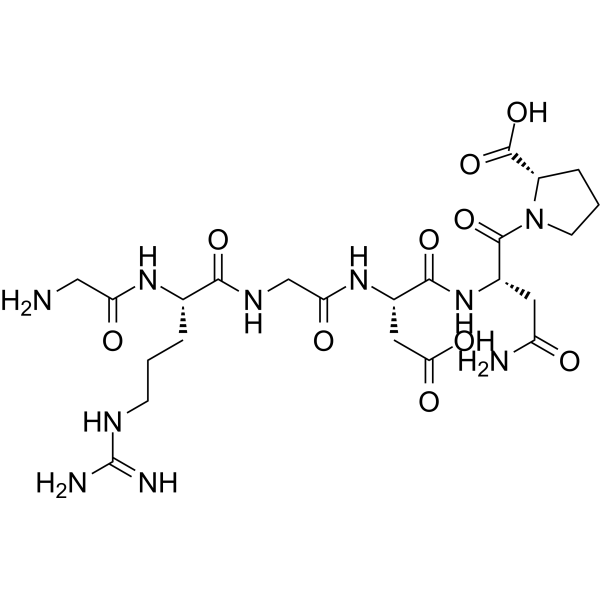
-
- HY-W717830
-
|
|
Biochemical Assay Reagents
|
Others
|
|
CB-Cyclamis a bifunctional chelator (Bifunctional Chelator; BFC), which is a main chain Cyclen derivative of the macrocyclic ligand tetradecane. CB-Cyclam can be used for conjugation of peptides and radionuclides.
|
-
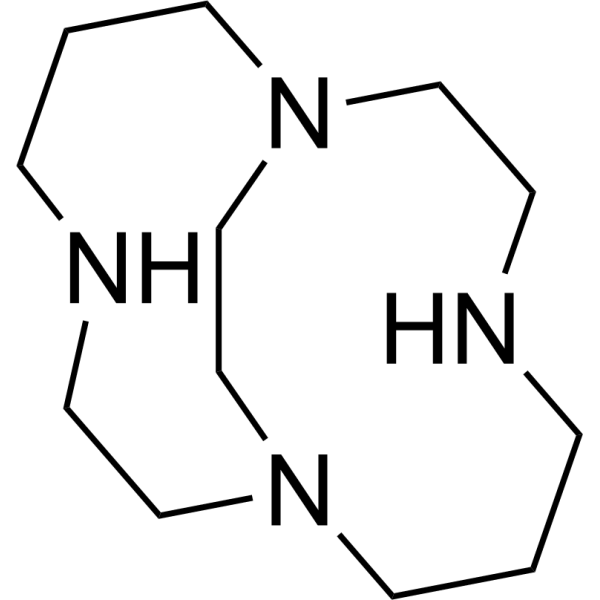
-
- HY-P2268A
-
|
|
Amyloid-β
|
Inflammation/Immunology
Cancer
|
|
RAGE antagonist peptide TFA is an advanced glycation end products (RAGE) antagonist. RAGE antagonist peptide TFA prevents RAGE from binding with several of its most important ligands, including HMGB-1, S100P, and S100A4. RAGE antagonist peptide TFA possesses anti-tumor and anti-inflammatory activities .
|
-

-
- HY-43869
-
|
PSMA-617 ligand-Linker Conjugate
|
ADC Linker
|
Cancer
|
|
Vipivotide tetraxetan Ligand-Linker Conjugate (PSMA-617 Ligand-Linker Conjugate) is a complex composed of pharmacophore group Glutamate-urea-Lysine peptide coupling linker, which can be used to synthesize Vipivotide tetraxetan (PSMA-617). Glutamate-urea-Lysine selectively binds to prostate-specific membrane antigen (PSMA) .
|
-
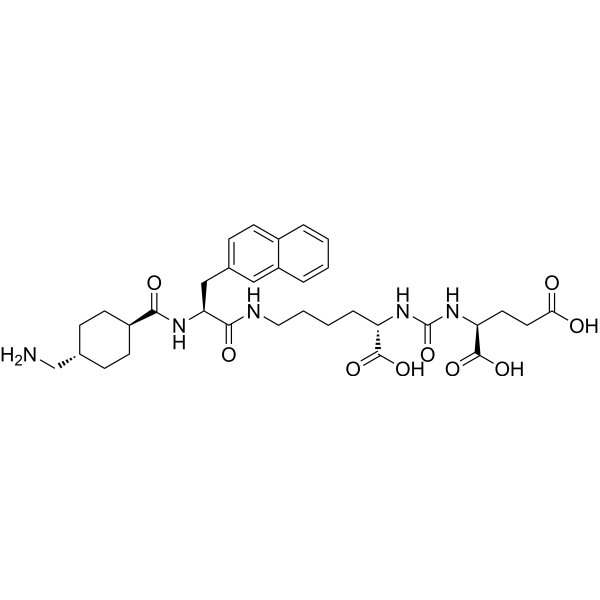
-
- HY-P1740A
-
|
|
Integrin
Apoptosis
|
Inflammation/Immunology
Cancer
|
|
RGD peptide (GRGDNP) TFA is an inhibitor of integrin-ligand interactions. RGD peptide (GRGDNP) TFA competitively inhibits α5β1 binding with extracellular matrice (ECM). RGD peptide (GRGDNP) TFA promotes apoptosis through activation of conformation changes that enhance pro-caspase-3 activation and autoprocessing. RGD peptide (GRGDNP) TFA plays an important role in cell adhesion, migration, growth, and differentiation .
|
-

-
- HY-P2264
-
|
|
Ephrin Receptor
|
Inflammation/Immunology
|
|
KYL peptide, an antagonistic peptide, selectively targets EphA4 receptor (IC50:4.22 μM, Kd:1.3 μM). KYL peptide binds to the ligand-binding domain of EphA4, effectively alleviates Aβ-induced synaptic dysfunction and synaptic plasticity defects in AD mice. KYL peptide can promote nerve regeneration after injury and modulating immune responses .
|
-
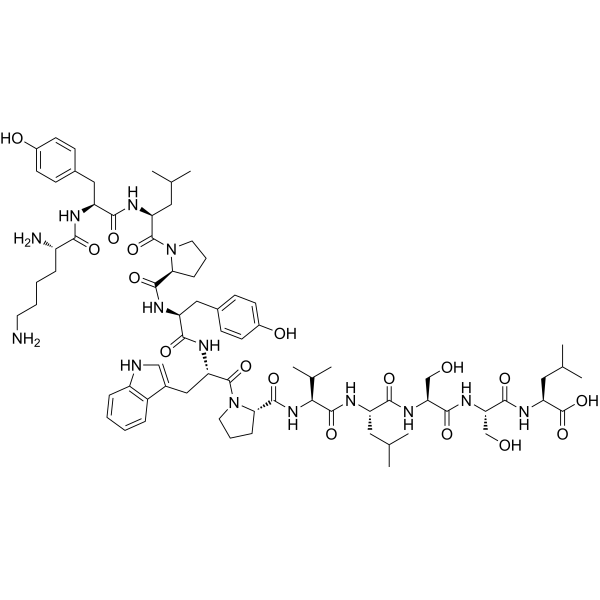
-
- HY-P3108
-
-
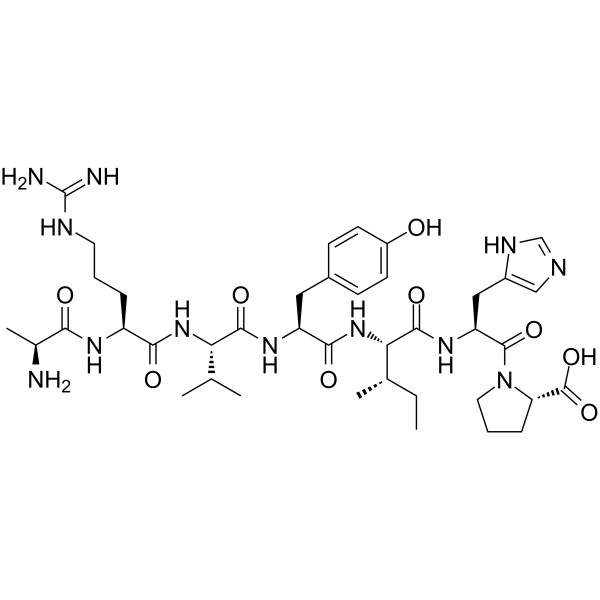
-
- HY-156138A
-
|
|
Biochemical Assay Reagents
|
Others
|
|
CB-TE2A (tetrahydrochloride)is a bifunctional chelator (Bifunctional Chelator; BFC), which is a TETA derivative of the macrocyclic ligand tetradecane backbone. CB-TE2A (tetrahydrochloride) can be used for conjugation of peptides and radionuclides.
|
-
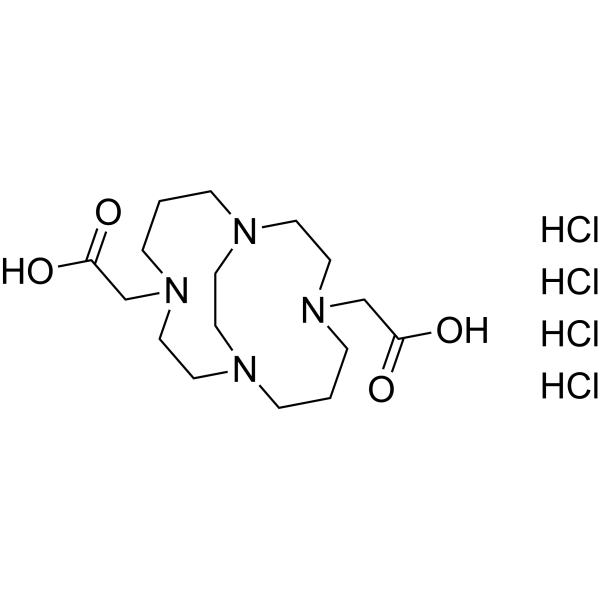
-
- HY-P0262
-
|
|
Neuropeptide Y Receptor
|
Neurological Disease
Metabolic Disease
Inflammation/Immunology
Endocrinology
|
|
Galantide, a non-specific galanin receptor antagonist, is a peptide consisting of fragments of galanin and substance P. Galantide recognizes two classes of galanin binding sites (KD<0.1 nM and ~6 nM) in the rat hypothalamus. Galantide dose dependently (IC50=1.0 nM) antagonizes the galanin-mediated inhibition of the glucose-induced insulin secretion from mouse pancreatic islets. Galantide appears to bind to a single population of SP receptors (KD~40 nM) .
|
-
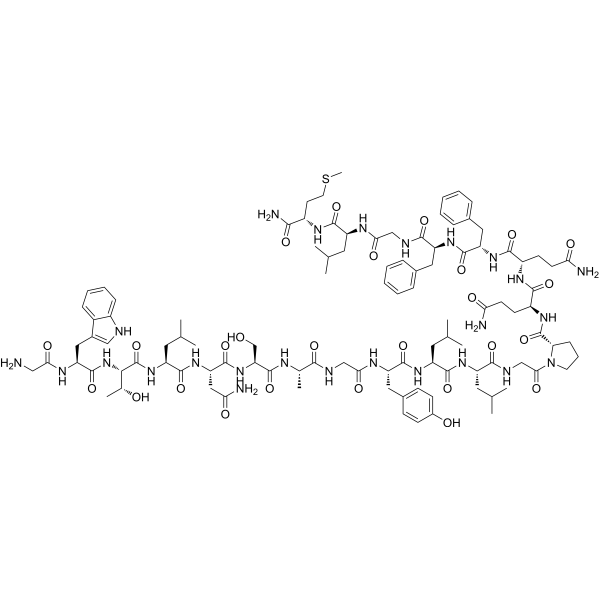
-
- HY-W717742
-
|
|
Biochemical Assay Reagents
|
Others
|
|
p-NO2-Bn-Cyclenis a bifunctional chelator (Bifunctional Chelator; BFC), which is a derivative of the macrocyclic ligand dodecane backbone Cyclen. p-NO2-Bn-Cyclen can be used for conjugation of peptides and radionuclides.
|
-
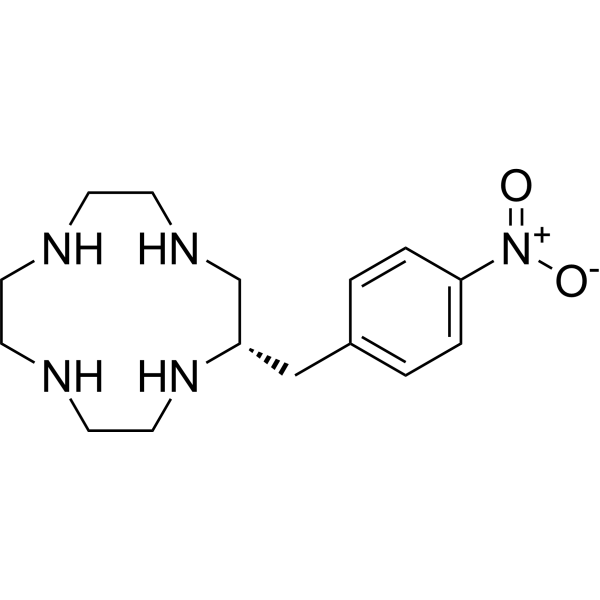
-
- HY-P3440
-
|
|
PD-1/PD-L1
|
Cancer
|
|
WL12 is a specifically targeting programmed death ligand 1 (PD-L1) binding peptide. WL12 can be radiolabeled by different radionuclides, generating radiotracers, which can assess the tumor PD-L1 expression .
|
-
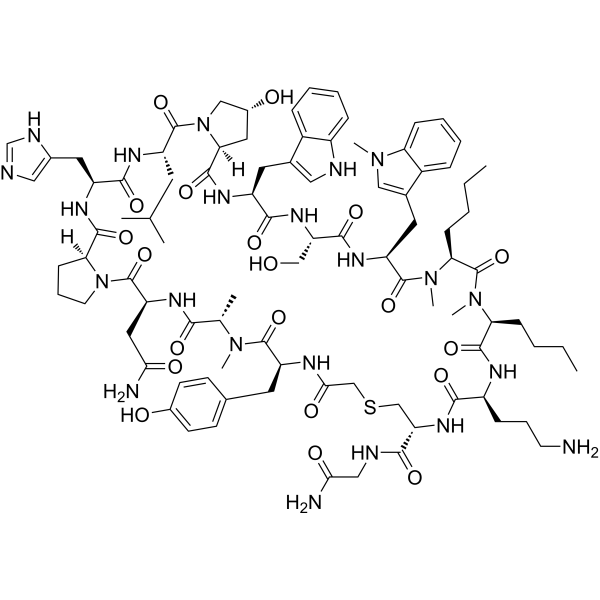
-
- HY-P2474
-
|
|
PD-1/PD-L1
|
Cancer
|
|
Human PD-L1 inhibitor I is a hPD-1 peptide ligand, with a KD of 3.39 μM. Human PD-L1 inhibitor I may disturb the binding of hPD-L1 to hPD-1 .
|
-

-
- HY-155788
-
|
|
Biochemical Assay Reagents
|
Others
|
|
DSPE-PEG-DBCO ammonium is the ammonium salt form of DSPE-PEG-DBCO. DSPE-PEG-DBCO ammonium is utilized in copper-free click chemistry through SPAAC conjugation with an azido-functionalized peptide ligand. DSPE-PEG-DBCO ammonium is applied in drug-delivery and nanoparticle research .
|
-

-
- HY-P3732
-
|
|
Integrin
|
Cancer
|
|
RGD-4C is a arginine-glycine-aspartic acid peptide (ACDCRGDCFC) with integrin binding activity. The Arg-Gly-Asp (RGD) sequence serves as the primary integrin recognition site in extracellular matrix proteins, and peptides containing this sequence can mimic the recognition specificity of the matrix proteins. RGD-4C is a αv-integrin ligand, can conjugate with bioactive molecule to exert antitumor effects in animal models .
|
-

-
- HY-P4095
-
|
|
CXCR
|
Cancer
|
|
NoxaBH3 is a cysteine-based cross-linked peptide with increased cell permeability and higher inhibitory activity against Mcl-1. NoxaBH3 binds to the endogenous CXCR4 ligand to produce ubiquitin-Noxabh3 conjugate. NoxaBH3 is then delivered to cancer cells .
|
-

-
- HY-P2159
-
|
|
Opioid Receptor
Endogenous Metabolite
|
Neurological Disease
|
|
Dynorphin A (1-8) is the predominant opioid peptide identified in placental tissue extracts. Dynorphin A (1-8) is the most likely natural ligand of the kappa receptor. The binding of 3H-Bremazocine to the purified kappa receptor is inhibited by Dynorphin A (1-8) (IC50=303 nM) .
|
-
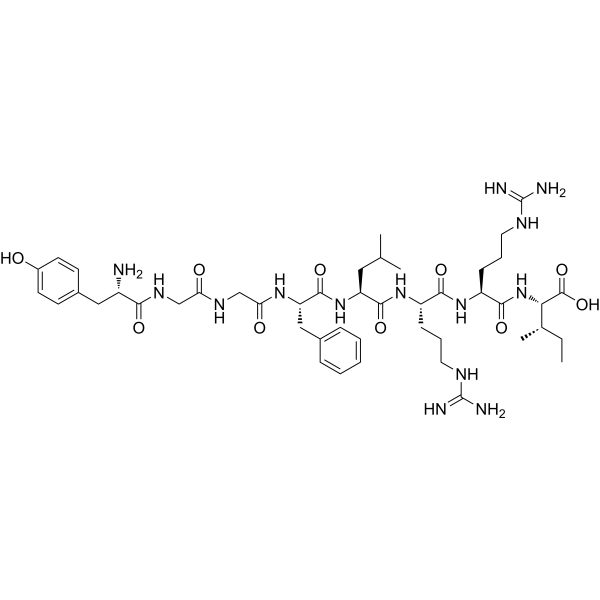
-
- HY-P5325
-
|
|
Bcl-2 Family
|
Others
|
|
Bid BH3 (80-99) is a biological active peptide. (BID is a pro-apoptotic member of the 'BH3-only' (BOPS) subset of the BCL-2 family of proteins that constitute a critical control point in apoptosis. Bid is the first of the BOPs reported to bind and activate Bcl-2, Bax, and Bak. Bid serves as a death-inducing ligand that moves from the cytosol to the mitochondrial membrane to inactivate Bcl-2 or to activate Bax.Pyroglutamyl (pGlu) peptides may spontaneously form when either Glutamine (Q) or Glutamic acid (E) is located at the sequence N-terminus. The conversion of Q or E to pGlu is a natural occurrence and in general it is believed that the hydrophobic γ-lactam ring of pGlu may play a role in peptide stability against gastrointestinal proteases. Pyroglutamyl peptides are therefore considered a normal subset of such peptides and are included as part of the peptide purity during HPLC analysis.)
|
-
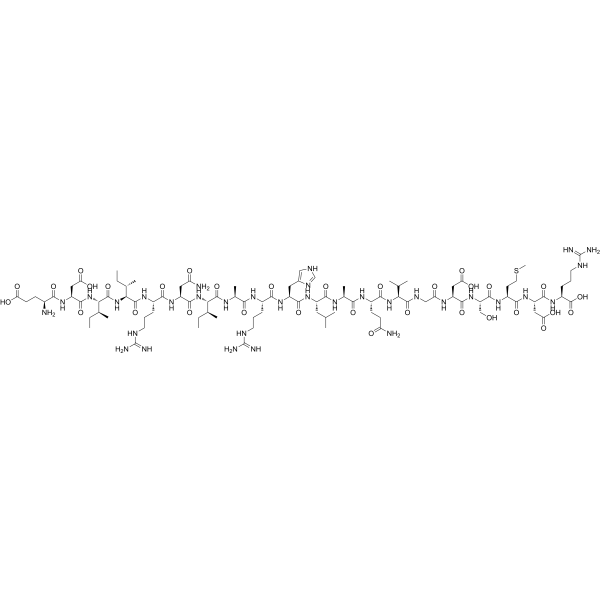
-
- HY-155470
-
|
|
Biochemical Assay Reagents
|
Cancer
|
|
IMP 243 is a symmetric di-HSG (histamine-succinyl-glycine) bivalent hapten containing a Tscg-Cys ligand and two HSG groups. IMP 243 can be radiolabeled with 99mTc-pertechnetate. IMP 243 can be conjugated to other peptides to design bispecific antibodies (bsMAbs) for cancer research .
|
-
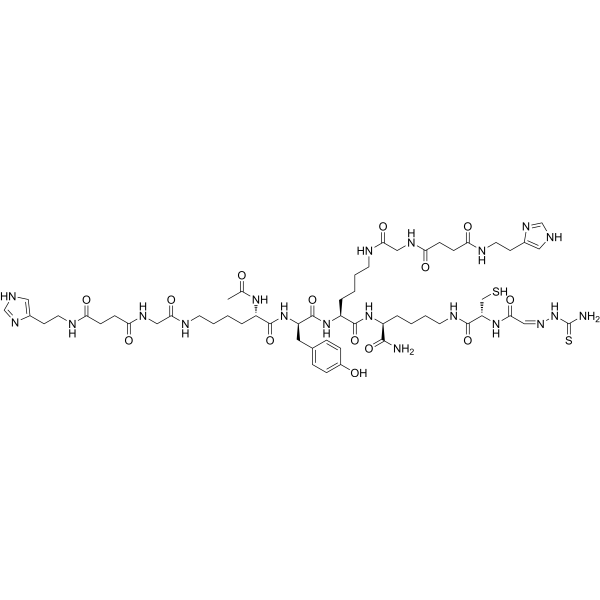
-
- HY-P1039
-
|
PHCVPRDLSWLDLEANMCLP
|
Raf
|
Cancer
|
|
R18 is a peptide antagonists of 14-3-3, with a KD of 70-90 nM. R18 efficiently blocks the binding of 14-3-3 to the kinase Raf-1, a physiological ligand of 14-3-3, and effectively abolished the protective role of 14-3-3 against phosphatase-induced inactivation of Raf-1 .
|
-

-
- HY-P1039A
-
|
PHCVPRDLSWLDLEANMCLP TFA
|
Raf
|
Cancer
|
|
R18 TFA is a peptide antagonists of 14-3-3, with a KD of 70-90 nM. R18 efficiently blocks the binding of 14-3-3 to the kinase Raf-1, a physiological ligand of 14-3-3, and effectively abolished the protective role of 14-3-3 against phosphatase-induced inactivation of Raf-1 .
|
-

-
- HY-P2518
-
|
|
Protease Activated Receptor (PAR)
|
Inflammation/Immunology
|
|
Protease-Activated Receptor-1, PAR-1 Agonist is a selective proteinase-activated receptor1 (PAR-1) agonist peptide. Protease-Activated Receptor-1, PAR-1 Agonist corresponds to PAR1 tethered ligand and which can selectively mimic theactions of thrombin via this receptor .
|
-
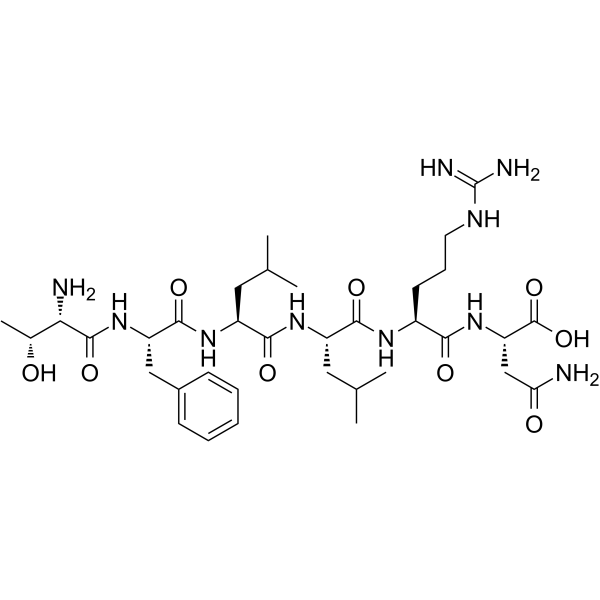
-
- HY-P2518A
-
|
|
Protease Activated Receptor (PAR)
|
Cancer
|
|
Protease-Activated Receptor-1, PAR-1 Agonist TFA is a selective proteinase-activated receptor1 (PAR-1) agonist peptide. Protease-Activated Receptor-1, PAR-1 Agonist TFA corresponds to PAR1 tethered ligand and which can selectively mimic theactions of thrombin via this receptor .
|
-
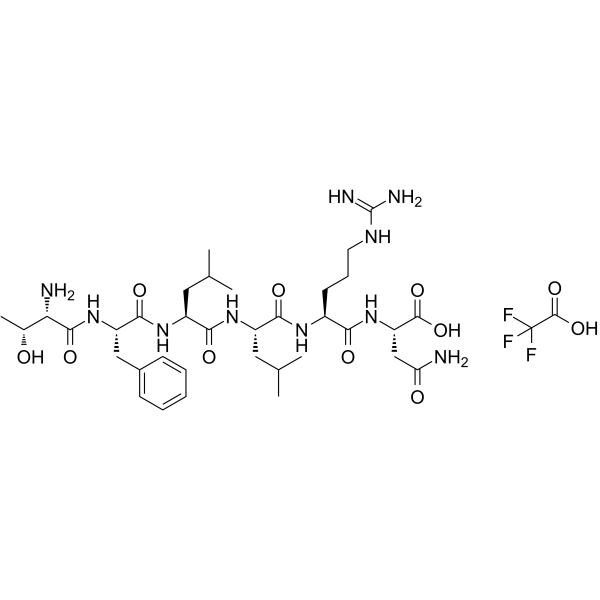
-
- HY-W019787
-
|
|
Opioid Receptor
CXCR
|
Neurological Disease
|
|
BAM-12P, an endogenous opioid peptide, is a novel pro-Met-enkephalin. BAM-12P can activate human κ-opioid receptor (hKOR) with an EC50 of 101 nM and a pEC50 of 6.99. BAM-12P is a ligand for CXCR7 with an EC50 of 175 nM .
|
-

-
- HY-P5038
-
|
c(GRGDSP)
|
Integrin
|
Cancer
|
|
Cyclo(Gly-Arg-Gly-Asp-Ser-Pro) (c(GRGDSP)) is an RGD-containing inhibitory peptide. Cyclo(Gly-Arg-Gly-Asp-Ser-Pro) is a synthetic α5β1 integrin ligand that competitively inhibits the binding of invasin (Inv) to α5β1 integrin expressed on Caco-2 cells .
|
-

-
- HY-P99263
-
|
Anti-Human selectin P Recombinant Antibody
|
P-selectin
|
Cardiovascular Disease
|
|
Inclacumab (Anti-Human selectin P Recombinant Antibody) is a human monoclonal IgG4 antibody selectively targets P-selectin with a Kd value of 9.9 nM. Inclacumab inhibits P-selectin glycoprotein ligand 1 (PSGL-1) mimetic peptide bind with P-selectin with an IC50 value of 1.9 μg/mL and strongly inhibits cell adhesion .
|
-

-
- HY-P3726
-
|
|
Integrin
|
Inflammation/Immunology
Cancer
|
|
Lys-Gln-Ala-Gly-Asp-Val (KQAGDV) is the six most carboxyl-terminal amino acids in the fibrinogen γ-chain sequence. Lys-Gln-Ala-Gly-Asp-Val is a cell adhesion peptide which is mediated through the α2bβ3 integrin. Lys-Gln-Ala-Gly-Asp-Val is a potent adhesion ligand for smooth muscle cells (SMCs) .
|
-

-
- HY-132205
-
|
|
Estrogen Receptor/ERR
|
Metabolic Disease
|
|
DS45500853 is an estrogen-related receptor α (ERRα) agonist. DS45500853 inhibits the binding between receptor-interacting protein 140 (RIP140) corepressor peptide (10 nM) and GST-ERRα ligand-binding domain (LBD; 1.2 μM) with an IC50 value of 0.80 μM. DS45500853 can be used for the research of metabolic disorders, including type 2 diabetes mellitus (T2DM) .
|
-
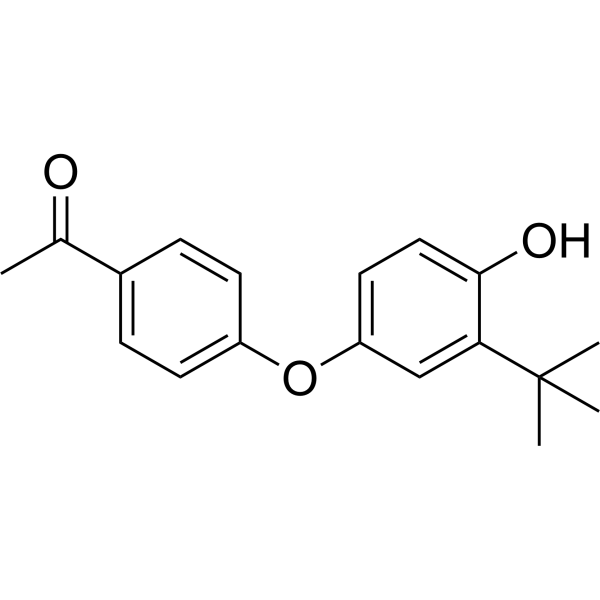
-
- HY-143201
-
|
|
Estrogen Receptor/ERR
|
Metabolic Disease
|
|
DS20362725 is an estrogen-related receptor α (ERRα) agonist. DS20362725 inhibits the binding between receptor-interacting protein 140 (RIP140) corepressor peptide (10 nM) and GST-ERRα ligand-binding domain (LBD; 1.2 μM) with an IC50 value of 0.6 μM. DS20362725 can be used for the research of metabolic disorders, including type 2 diabetes mellitus (T2DM) .
|
-

-
- HY-155992
-
|
|
Sigma Receptor
|
Neurological Disease
|
|
WLB-89462 (Compound 20c) is a selective σ2 receptor ligand (Ki: 13 nM). WLB-89462 has neuroprotective activity. WLB-89462 improves short-term memory impairment induced by Aβ peptide in rats. WLB-89462 has good ADMET profile (good solubility, no CYP inhibition, good metabolic stability, high permeability, brain penetration, and high oral exposure in rodents) .
|
-

-
- HY-111866
-
|
|
PROTACs
RIP kinase
|
Metabolic Disease
Cancer
|
|
PROTAC RIPK degraders -2 is a non-peptide PROTAC based on von Hippel-Lindau and targets serine-threonine kinase RIPK2, which is highly selective to the degradation of RIPK2. PROTAC RIPK degrader-2 acts as an activator to increase cell death and activate ion channels in cancer cells. PROTAC RIPK degrader-2 also can inhibit protein interactions, such as receptors and ligands, involved in a variety of diseases, such as cancer and diabetes .
|
-

-
- HY-158033
-
|
|
LYTACs
|
Cancer
|
|
Biotin-εNle-CKCKC-γAbu-CKCKCG-NH2 (Compound 24, Cys modified with M6Pn) is a mannose-6-phosphate (M6Pn)-peptide conjugate capable of binding to targeted ligands of various proteins and successfully internalizing and degrading them through M6PR. Biotin-εNle-CKCKC-γAbu-CKCKCG-NH2 can be utilized in the research of lysosomal targeting chimeras (LYTACs) based on M6Pn .
|
-
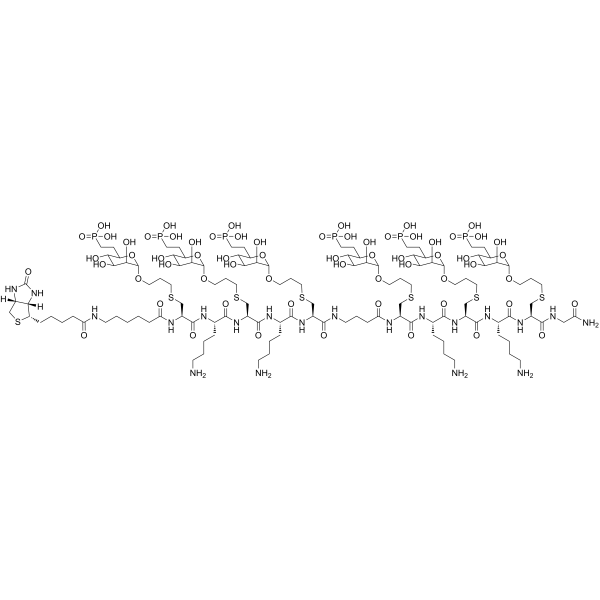
-
- HY-P5380
-
|
|
MMP
|
Others
|
|
TNO211 is a biological active peptide. (Matrix Metalloproteinases (MMPs) are a large family of endopeptidases. Collectively, MMPs can degrade all kinds of extracellular matrix proteins, and can also process a number of bioactive molecules. They are known to be involved in the cleavage of cell surface receptors, the release of apoptotic ligands, and chemokine/cytokine inactivation. MMPs are also thought to play a major role in cell behaviors such as cell proliferation, migration (adhesion/dispersion), differentiation, angiogenesis, apoptosis, and host defense.This peptide is a highly soluble fluorogenic MMP substrate for MMP-2, 8, 12, 13 and 14, containing the MMP cleavable Gly-Leu bond and EDANS/DABCYL. Fluorogenic assays using TNO211 are sensitive and can detect MMP activity in culture medium from endothelial cells and untreated synovial fluid from patients. Abs/Em = 340/490 nm.)
|
-

| Cat. No. |
Product Name |
Type |
-
- HY-W717830
-
|
|
Chelators
|
|
CB-Cyclamis a bifunctional chelator (Bifunctional Chelator; BFC), which is a main chain Cyclen derivative of the macrocyclic ligand tetradecane. CB-Cyclam can be used for conjugation of peptides and radionuclides.
|
-
- HY-156138A
-
|
|
Chelators
|
|
CB-TE2A (tetrahydrochloride)is a bifunctional chelator (Bifunctional Chelator; BFC), which is a TETA derivative of the macrocyclic ligand tetradecane backbone. CB-TE2A (tetrahydrochloride) can be used for conjugation of peptides and radionuclides.
|
-
- HY-W717742
-
|
|
Chelators
|
|
p-NO2-Bn-Cyclenis a bifunctional chelator (Bifunctional Chelator; BFC), which is a derivative of the macrocyclic ligand dodecane backbone Cyclen. p-NO2-Bn-Cyclen can be used for conjugation of peptides and radionuclides.
|
| Cat. No. |
Product Name |
Target |
Research Area |
-
- HY-P5964A
-
-
- HY-P5889
-
|
|
Thrombin
|
Cardiovascular Disease
|
|
Thrombin receptor peptide ligand is a thrombin receptor antagonist peptide that can be used as an antithrombotic agent .
|
-
- HY-P4205
-
|
|
Aminopeptidase
|
Cancer
|
|
Aminopeptidase N Ligand (CD13) NGR peptide is a polypeptide targeting CD13 and can be used as a carrier to mediate intracellular transmission. Aminopeptidase N Ligand (CD13) NGR peptide is often used in cancer research .
|
-
- HY-P1868
-
|
DGEA peptide
|
Integrin
|
Infection
|
|
α2β1 Integrin Ligand Peptide interacts with the α2β1 integrin receptor on the cell membrane and mediates extracellular signals into cells. It is a potential antagonist of collagen receptors .
|
-
- HY-P5964
-
-
- HY-P1868A
-
|
DGEA peptide TFA
|
Integrin
|
Others
|
|
α2β1 Integrin Ligand Peptide TFA interacts with the α2β1 integrin receptor on the cell membrane and mediates extracellular signals into cells. It is a potential antagonist of collagen receptors .
|
-
- HY-P4015
-
|
|
Peptides
|
Neurological Disease
Metabolic Disease
|
|
VIP (1-12), human, porcine, rat, ovine is a vasoactive intestinal peptide (VIP) fragment. VIP (1-12), human, porcine, rat, ovine is a ligand for the CD4 (T4)/human immunodeficiency virus receptor .
|
-
- HY-P1996
-
|
NBI-5788
|
Peptides
|
Neurological Disease
Inflammation/Immunology
|
|
Tiplimotide (NBI-5788) is an altered peptide ligand (APL) designed from an immunodominant region (83-99) of the neuroantigen myelin basic protein (MBP). Tiplimotide can selectively reduce the production of inflammatory cytokines by pathogenic T-cells. Tiplimotide can be used for the research of multiple sclerosis (MS) .
|
-
- HY-P1186
-
|
Eledoisin-Related peptide; Eledoisin RP
|
Neurokinin Receptor
|
Neurological Disease
|
|
Eledoisin Related Peptide is a Substance P analog that excites neurons and triggers behavioral responses. Eledoisin Related Peptide is also a tachykinin receptor ligand.
|
-
- HY-P1530
-
|
|
Peptides
|
Neurological Disease
|
|
Prolactin Releasing Peptide (12-31), human is a fragment of the prolactin releasing peptide (PrRP). Prolactin Releasing Peptide (1-31), human is a high affinity GPR10 ligand that cause the release of the prolactin.
|
-
- HY-P4198
-
-
- HY-P4803
-
-
- HY-W343750
-
-
- HY-P5408
-
|
SIIQFEHL, OVA (257-264) Variant
|
Peptides
|
Others
|
|
OVA-Q4H7 Peptide (SIIQFEHL, OVA (257-264) Variant) is a biological active peptide. (Q4H7 Peptide (SIIQFEHL) is a variant of the agonist ovalbumin (OVA) peptide (257-264), SIINFEKL, the strongest positive selecting ligand.)
|
-
- HY-P0272
-
|
|
HIV
|
Infection
|
|
Peptide T is an octapeptide from the V2 region of HIV-1 gp120. Peptide T is a ligand for the CD4 receptor and prevents binding of HIV to the CD4 receptor.
|
-
- HY-P0272A
-
|
|
HIV
|
Infection
|
|
Peptide T (TFA) is an octapeptide from the V2 region of HIV-1 gp120. Peptide T is a ligand for the CD4 receptor and prevents binding of HIV to the CD4 receptor.
|
-
- HY-P4116
-
|
pHLIP
|
Peptides
|
Others
|
|
pH-Low Insertion Peptide (pHLIP) used as a specific ligand to target the tumor acidic microenvironment for tumors at early and metastatic stages .
|
-
- HY-P0224
-
|
fMLP; N-Formyl-MLF
|
TNF Receptor
|
Inflammation/Immunology
|
|
N-Formyl-Met-Leu-Phe (fMLP; N-Formyl-MLF) is a chemotactic peptide and a specific ligand of N-formyl peptide receptor (FPR). N-Formyl-Met-Leu-Ph is reported to inhibit TNF-alpha secretion.
|
-
- HY-P1915
-
|
|
Peptides
|
Metabolic Disease
|
|
26Rfa, Hypothalamic Peptide, human is a hypothalamic neuropeptide of the RFamide peptide family with orexigenic activity . 26RFa is an orexigenic neuropeptide identified as the endogenous ligand of the orphan G protein-coupled receptor GPR103 .
|
-
- HY-P5371
-
|
|
Thrombin
|
Others
|
|
TFLLRNPNDK-NH2 is a biological active peptide. (This peptide is a thrombin receptor activating peptide. This PAR-1 agonist peptide reversibly binds to PAR-1 mimicking the 'tethered ligand' that thrombin makes available through proteolytic cleavage of substrate. It is also known to cause increase in liquid and protein permeability much like thrombin.)
|
-
- HY-P0260
-
-
- HY-P3130
-
|
|
CRFR
|
Neurological Disease
Inflammation/Immunology
|
|
Stresscopin-related peptide (human) is a specific ligand for the type 2 CRH receptor. Stresscopin-related peptide (human) suppresses food intake, delayed gastric emptying and decreases heat-induced edema. Stresscopin-related peptide (human) maintains homeostasis after stress, and can be used in the research of stress-related diseases .
|
-
- HY-P4715
-
|
|
PTHR
|
Endocrinology
|
|
(Tyr36)-pTH-Related Protein (1-36) (human, mouse, rat) is a peptide and can be used as a parathyroid hormone (PTH) receptor ligand .
|
-
- HY-P1520
-
|
|
GnRH Receptor
|
Neurological Disease
|
|
Prolactin Releasing Peptide (1-31), human is a high affinity GPR10 ligand that cause the release of the prolactin. Prolactin Releasing Peptide (1-31) binds to GPR10 for human and rats with Ki values of 1.03 nM and 0.33 nM, respectively. Prolactin Releasing Peptide (1-31) can be used for the research of the hypothalamo-pituitary axis .
|
-
- HY-P2268
-
|
|
Amyloid-β
|
Inflammation/Immunology
Cancer
|
|
RAGE antagonist peptide is an advanced glycation end products (RAGE) antagonist. RAGE antagonist peptide prevents RAGE from binding with several of its most important ligands, including HMGB-1, S100P, and S100A4. RAGE antagonist peptide (RAP) possesses anti-tumor and anti-inflammatory activities .
|
-
- HY-P1520A
-
|
|
GnRH Receptor
|
Neurological Disease
|
|
Prolactin Releasing Peptide (1-31), human (acetate) is a high affinity GPR10 ligand that causes the release of the prolactin. Prolactin Releasing Peptide (1-31) binds to GPR10 for human and rats with Ki values of 1.03 nM and 0.33 nM, respectively. Prolactin Releasing Peptide (1-31) can be used for the research of the hypothalamo-pituitary axis .
|
-
- HY-P10089
-
|
|
Peptides
|
Inflammation/Immunology
|
|
TREM-1 inhibitory peptide M3 is a ligand-dependent TREM-1 antagonist. TREM-1 inhibitory peptide M3 can inhibit systemic and pulmonary pro-inflammatory cytokine and chemokine production and attenuate acute lung injury .
|
-
- HY-P1740
-
|
|
Integrin
Apoptosis
|
Inflammation/Immunology
|
|
RGD peptide (GRGDNP) is an inhibitor of integrin-ligand interactions. RGD peptide (GRGDNP) competitively inhibits α5β1 binding with extracellular matrice (ECM). RGD peptide (GRGDNP) promotes apoptosis through activation of conformation changes that enhance pro-caspase-3 activation and autoprocessing. RGD peptide (GRGDNP) plays an important role in cell adhesion, migration, growth, and differentiation .
|
-
- HY-106171
-
|
|
Peptides
|
Metabolic Disease
|
|
NBI-6024, an altered peptide ligand (APL), is an epitope recognized by inflammatory interferon-gamma-producing T helper lymphocytes in type 1 diabetic patients .
|
-
- HY-P2268A
-
|
|
Amyloid-β
|
Inflammation/Immunology
Cancer
|
|
RAGE antagonist peptide TFA is an advanced glycation end products (RAGE) antagonist. RAGE antagonist peptide TFA prevents RAGE from binding with several of its most important ligands, including HMGB-1, S100P, and S100A4. RAGE antagonist peptide TFA possesses anti-tumor and anti-inflammatory activities .
|
-
- HY-P1507
-
|
|
Peptides
|
Cardiovascular Disease
|
|
Fibrinogen Binding Inhibitor Peptide is a dodecapeptide (HHLGGAKQAGDV, H12), which is a fibrinogen γ-chain carboxy-terminal sequence (γ400-411). Fibrinogen Binding Inhibitor Peptide is a specific binding site of the ligand for activated glycoprotein (GP) IIb/IIIa.
|
-
- HY-P4689
-
|
|
Peptides
|
Metabolic Disease
|
|
Prolactin-Releasing Peptide (1-31) (rat) is a UHR-1/GRP10 receptor ligand. Prolactin-Releasing Peptide (1-31) (rat) reduces fasting-induced food intake, increases plasma levels of LH, FSH, and testosterone in rats .
|
-
- HY-P1740A
-
|
|
Integrin
Apoptosis
|
Inflammation/Immunology
Cancer
|
|
RGD peptide (GRGDNP) TFA is an inhibitor of integrin-ligand interactions. RGD peptide (GRGDNP) TFA competitively inhibits α5β1 binding with extracellular matrice (ECM). RGD peptide (GRGDNP) TFA promotes apoptosis through activation of conformation changes that enhance pro-caspase-3 activation and autoprocessing. RGD peptide (GRGDNP) TFA plays an important role in cell adhesion, migration, growth, and differentiation .
|
-
- HY-P2264
-
|
|
Ephrin Receptor
|
Inflammation/Immunology
|
|
KYL peptide, an antagonistic peptide, selectively targets EphA4 receptor (IC50:4.22 μM, Kd:1.3 μM). KYL peptide binds to the ligand-binding domain of EphA4, effectively alleviates Aβ-induced synaptic dysfunction and synaptic plasticity defects in AD mice. KYL peptide can promote nerve regeneration after injury and modulating immune responses .
|
-
- HY-P5458
-
|
|
Peptides
|
Others
|
|
SRC-1 (686-700) is a biological active peptide. (This peptide is amino acids 686 to 700 fragment containing the second LXXLL motif, derived from NR box II of steroid receptor coactivator (SRC1). Coactivator proteins interact with nuclear receptors in a ligand-dependent manner and augment transcription.)
|
-
- HY-P3108
-
-
- HY-P5392
-
|
|
Peptides
|
Others
|
|
Apelin-16, human, bovine is a biological active peptide. (Apelin is the endogenous ligand for the G-protein-coupled APJ receptor. It is produced as a pre-proprotein of 77 amino acids.Apelin-16 is one of the active fragment of Apelin)
|
-
- HY-P0262
-
|
|
Neuropeptide Y Receptor
|
Neurological Disease
Metabolic Disease
Inflammation/Immunology
Endocrinology
|
|
Galantide, a non-specific galanin receptor antagonist, is a peptide consisting of fragments of galanin and substance P. Galantide recognizes two classes of galanin binding sites (KD<0.1 nM and ~6 nM) in the rat hypothalamus. Galantide dose dependently (IC50=1.0 nM) antagonizes the galanin-mediated inhibition of the glucose-induced insulin secretion from mouse pancreatic islets. Galantide appears to bind to a single population of SP receptors (KD~40 nM) .
|
-
- HY-P10086
-
|
Human TREM-1(213-221)
|
Peptides
|
Inflammation/Immunology
|
|
TREM-1 inhibitory peptide GF9 (Human TREM-1(213-221)) is a ligand‐independent TREM‐1 inhibitory nonapeptide GF9 that can blunt excessive inflammation caused by rheumatoid arthritis (RA) .
|
-
- HY-P3440
-
|
|
PD-1/PD-L1
|
Cancer
|
|
WL12 is a specifically targeting programmed death ligand 1 (PD-L1) binding peptide. WL12 can be radiolabeled by different radionuclides, generating radiotracers, which can assess the tumor PD-L1 expression .
|
-
- HY-P2474
-
|
|
PD-1/PD-L1
|
Cancer
|
|
Human PD-L1 inhibitor I is a hPD-1 peptide ligand, with a KD of 3.39 μM. Human PD-L1 inhibitor I may disturb the binding of hPD-L1 to hPD-1 .
|
-
- HY-P2472
-
|
26RFa (mouse, rat)
|
Peptides
|
Metabolic Disease
|
|
Orphan GPCR SP9155 agonist P550 (mouse, rat) (26RFa (mouse, rat)), a member of the RFamide peptide family with orexigenic effect, is the cognate ligand of the mouse orphan receptor GPR103, also designated SP9155 or AQ27 .
|
-
- HY-P1239
-
|
|
Peptides
|
Neurological Disease
|
|
Neuromedin S(rat) is a 34-amino acids peptide from rat Neuromedin S. Neuromedin S is a neuropeptide isolated from rat brain. Neuromedin S acts as a ligand for the G protein-coupled receptor FM4/TGR-1
|
-
- HY-P3732
-
|
|
Integrin
|
Cancer
|
|
RGD-4C is a arginine-glycine-aspartic acid peptide (ACDCRGDCFC) with integrin binding activity. The Arg-Gly-Asp (RGD) sequence serves as the primary integrin recognition site in extracellular matrix proteins, and peptides containing this sequence can mimic the recognition specificity of the matrix proteins. RGD-4C is a αv-integrin ligand, can conjugate with bioactive molecule to exert antitumor effects in animal models .
|
-
- HY-P1239A
-
|
|
Peptides
|
Neurological Disease
|
|
Neuromedin S(rat) TFA is a 34-amino acids peptide from rat Neuromedin S. Neuromedin S is a neuropeptide isolated from rat brain. Neuromedin S acts as a ligand for the G protein-coupled receptor FM4/TGR-1
|
-
- HY-P4095
-
|
|
CXCR
|
Cancer
|
|
NoxaBH3 is a cysteine-based cross-linked peptide with increased cell permeability and higher inhibitory activity against Mcl-1. NoxaBH3 binds to the endogenous CXCR4 ligand to produce ubiquitin-Noxabh3 conjugate. NoxaBH3 is then delivered to cancer cells .
|
-
- HY-P2159
-
|
|
Opioid Receptor
Endogenous Metabolite
|
Neurological Disease
|
|
Dynorphin A (1-8) is the predominant opioid peptide identified in placental tissue extracts. Dynorphin A (1-8) is the most likely natural ligand of the kappa receptor. The binding of 3H-Bremazocine to the purified kappa receptor is inhibited by Dynorphin A (1-8) (IC50=303 nM) .
|
-
- HY-P5325
-
|
|
Bcl-2 Family
|
Others
|
|
Bid BH3 (80-99) is a biological active peptide. (BID is a pro-apoptotic member of the 'BH3-only' (BOPS) subset of the BCL-2 family of proteins that constitute a critical control point in apoptosis. Bid is the first of the BOPs reported to bind and activate Bcl-2, Bax, and Bak. Bid serves as a death-inducing ligand that moves from the cytosol to the mitochondrial membrane to inactivate Bcl-2 or to activate Bax.Pyroglutamyl (pGlu) peptides may spontaneously form when either Glutamine (Q) or Glutamic acid (E) is located at the sequence N-terminus. The conversion of Q or E to pGlu is a natural occurrence and in general it is believed that the hydrophobic γ-lactam ring of pGlu may play a role in peptide stability against gastrointestinal proteases. Pyroglutamyl peptides are therefore considered a normal subset of such peptides and are included as part of the peptide purity during HPLC analysis.)
|
-
- HY-P1039
-
|
PHCVPRDLSWLDLEANMCLP
|
Raf
|
Cancer
|
|
R18 is a peptide antagonists of 14-3-3, with a KD of 70-90 nM. R18 efficiently blocks the binding of 14-3-3 to the kinase Raf-1, a physiological ligand of 14-3-3, and effectively abolished the protective role of 14-3-3 against phosphatase-induced inactivation of Raf-1 .
|
-
- HY-P1039A
-
|
PHCVPRDLSWLDLEANMCLP TFA
|
Raf
|
Cancer
|
|
R18 TFA is a peptide antagonists of 14-3-3, with a KD of 70-90 nM. R18 efficiently blocks the binding of 14-3-3 to the kinase Raf-1, a physiological ligand of 14-3-3, and effectively abolished the protective role of 14-3-3 against phosphatase-induced inactivation of Raf-1 .
|
- HY-P2518
-
|
|
Protease Activated Receptor (PAR)
|
Inflammation/Immunology
|
|
Protease-Activated Receptor-1, PAR-1 Agonist is a selective proteinase-activated receptor1 (PAR-1) agonist peptide. Protease-Activated Receptor-1, PAR-1 Agonist corresponds to PAR1 tethered ligand and which can selectively mimic theactions of thrombin via this receptor .
|
- HY-P2518A
-
|
|
Protease Activated Receptor (PAR)
|
Cancer
|
|
Protease-Activated Receptor-1, PAR-1 Agonist TFA is a selective proteinase-activated receptor1 (PAR-1) agonist peptide. Protease-Activated Receptor-1, PAR-1 Agonist TFA corresponds to PAR1 tethered ligand and which can selectively mimic theactions of thrombin via this receptor .
|
- HY-W019787
-
|
|
Opioid Receptor
CXCR
|
Neurological Disease
|
|
BAM-12P, an endogenous opioid peptide, is a novel pro-Met-enkephalin. BAM-12P can activate human κ-opioid receptor (hKOR) with an EC50 of 101 nM and a pEC50 of 6.99. BAM-12P is a ligand for CXCR7 with an EC50 of 175 nM .
|
- HY-P5373
-
|
|
Peptides
|
Others
|
|
Ser-parafluoroPhe-Aad-Leu-Arg-Asn-Pro-NH2 is a biological active peptide. (Structure-activity studies of thrombin receptor-tethered ligand SFLLRNP have revealed
the importance of the Phe-2-phenyl group in receptor recognition and the replacement of the
Phe-2 by para-fluorophenylalanine [(p-F)Phe] was found to enhance its activity)
|
- HY-P5038
-
|
c(GRGDSP)
|
Integrin
|
Cancer
|
|
Cyclo(Gly-Arg-Gly-Asp-Ser-Pro) (c(GRGDSP)) is an RGD-containing inhibitory peptide. Cyclo(Gly-Arg-Gly-Asp-Ser-Pro) is a synthetic α5β1 integrin ligand that competitively inhibits the binding of invasin (Inv) to α5β1 integrin expressed on Caco-2 cells .
|
- HY-W006069
-
|
|
Peptides
|
Others
|
|
H-Phe(3,5-DiF)-OH is a difluorophenylalanines in the L-configuration [L-(F2)Phe]. H-Phe(3,5-DiF)-OH can be incorporated into the thrombin receptor-tethered ligand peptide SFLLRNP to identify the phenyl hydrogens of the Phe-2 residue involved in the CH/π receptor interaction .
|
- HY-P1922
-
|
|
Peptides
|
Endocrinology
|
|
γ-2-MSH (41-58), amide is derived from γ-2-MSH. γ-2-MSH is a twelve amino acid peptide that is derived from the N-terminal fragment of proopiomelanocortin (POMC) and contains the His-Phe-Arg-Trp motif common to all melanocortin endogenous agonist ligands .
|
- HY-P3726
-
|
|
Integrin
|
Inflammation/Immunology
Cancer
|
|
Lys-Gln-Ala-Gly-Asp-Val (KQAGDV) is the six most carboxyl-terminal amino acids in the fibrinogen γ-chain sequence. Lys-Gln-Ala-Gly-Asp-Val is a cell adhesion peptide which is mediated through the α2bβ3 integrin. Lys-Gln-Ala-Gly-Asp-Val is a potent adhesion ligand for smooth muscle cells (SMCs) .
|
- HY-P5380
-
|
|
MMP
|
Others
|
|
TNO211 is a biological active peptide. (Matrix Metalloproteinases (MMPs) are a large family of endopeptidases. Collectively, MMPs can degrade all kinds of extracellular matrix proteins, and can also process a number of bioactive molecules. They are known to be involved in the cleavage of cell surface receptors, the release of apoptotic ligands, and chemokine/cytokine inactivation. MMPs are also thought to play a major role in cell behaviors such as cell proliferation, migration (adhesion/dispersion), differentiation, angiogenesis, apoptosis, and host defense.This peptide is a highly soluble fluorogenic MMP substrate for MMP-2, 8, 12, 13 and 14, containing the MMP cleavable Gly-Leu bond and EDANS/DABCYL. Fluorogenic assays using TNO211 are sensitive and can detect MMP activity in culture medium from endothelial cells and untreated synovial fluid from patients. Abs/Em = 340/490 nm.)
|
-
- HY-K0224
-
|
|
|
Amino magnetic beads (200 nm,10 mg/mL) can easily and efficiently combine with a variety of biological ligand in high loads, such as proteins, peptides, oligonucleotides, drug molecules, etc. It can be used as a good basic material for subsequent processing, adsorption, chemical modification and other follow-up processing.
|
-
- HY-K0225
-
|
|
|
MCE Carboxyl Magnetic beads (200 nm, 10 mg/mL) are characterized by superparamagnetism, fast magnetic response, abundant carboxyl functional groups, monodispersity, and submicron scale particle size. Biological ligands (proteins, peptides, oligonucleotides, drug molecules, etc.) can be covalently coupled to the surface of microspheres under the action of special chemical reagents (such as EDC).
|
| Cat. No. |
Product Name |
Target |
Research Area |
-
- HY-P99263
-
|
Anti-Human selectin P Recombinant Antibody
|
P-selectin
|
Cardiovascular Disease
|
|
Inclacumab (Anti-Human selectin P Recombinant Antibody) is a human monoclonal IgG4 antibody selectively targets P-selectin with a Kd value of 9.9 nM. Inclacumab inhibits P-selectin glycoprotein ligand 1 (PSGL-1) mimetic peptide bind with P-selectin with an IC50 value of 1.9 μg/mL and strongly inhibits cell adhesion .
|
| Cat. No. |
Product Name |
Category |
Target |
Chemical Structure |
| Cat. No. |
Product Name |
|
Classification |
-
- HY-155788
-
|
|
|
DBCO
|
|
DSPE-PEG-DBCO ammonium is the ammonium salt form of DSPE-PEG-DBCO. DSPE-PEG-DBCO ammonium is utilized in copper-free click chemistry through SPAAC conjugation with an azido-functionalized peptide ligand. DSPE-PEG-DBCO ammonium is applied in drug-delivery and nanoparticle research .
|
-
- HY-153486
-
|
|
|
Azide
|
|
N3-VC-PAB-PNP is the intermediate of bicyclic peptide ligand STING conjugates . N3-VC-PAB-PNP is a click chemistry reagent, it contains an Azide group and can undergo copper-catalyzed azide-alkyne cycloaddition reaction (CuAAc) with molecules containing Alkyne groups. Strain-promoted alkyne-azide cycloaddition (SPAAC) can also occur with molecules containing DBCO or BCN groups.
|
Your information is safe with us. * Required Fields.
Inquiry Information
- Product Name:
- Cat. No.:
- Quantity:
- MCE Japan Authorized Agent:













![[Tyr4]-Bombesin](http://file.medchemexpress.com/product_pic/hy-w343750.gif)










































